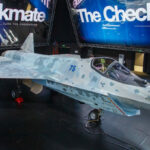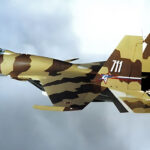The concept of modern multirole combat aircraft is becoming a thing of the past due to the duration of development and rising costs by the time serial production begins. In this regard, operational-tactical aviation (OTA) aircraft complexes in the future should go from being multifunctional, as they are now, to becoming specialised in terms of the range of tasks to be performed. This opinion was expressed by Mikhail Strelets, First Deputy Managing Director – Director of Sukhoi Design Bureau, UAC Deputy General Designer for Military Aviation, in an interview with the press service of the United Aircraft Corporation when discussing the sixth generation combat aircraft.
“When discussing the concept of prospects, we are of the opinion that the sixth-generation aircraft will essentially be more of a system than a complex. This means that within this system there will be several platforms that are not multifunctional in the sense that we have now for the fifth generation. They will solve more specialised tasks and complement each other. This will reduce the cost of each such component and the development time, which is now required of us by the state customer represented by the Ministry of Defence,” said Mikhail Strelets.
According to him, with the development of technologies, the system will be built on the elements of network centricity and artificial intelligence. “It is unfair to say that such a system will be unmanned or manned. It will probably include optionally manned aircraft, and some of its individual components may be completely unmanned,” the Sukhoi CEO noted.
He explained that the more requirements to the complex set by the customer, the longer the development takes, the cost of development work grows, and the final product becomes obsolete in the process of creation.
“By the time of launch into serial production, some of the decisions taken need to be revised, transferred to the current element base, current materials and technologies. How expedient this is is a big question. Such conceptual multifunctional platforms, in my opinion, should still be limited in terms of the range of tasks to be solved. There should be several different types of vehicles complementing each other,” said Mikhail Strelets.
The Russian Ministry of Defence defines a multifunctional fighter as an aircraft complex designed to perform fighter missions within the scope of a fighter aircraft and strike missions within the scope of available capabilities, mainly using strike weapons without conversion of the aircraft.
The first step towards the creation of domestic multirole combat aircraft was made on 17 May 1957, when the directive of the Chief of General Staff of the USSR Armed Forces gave the start to the development of a new type of aviation – fighter-bomber. The Air Force leadership proposed that the Sukhoi Design Bureau create the Su-7B fighter-bomber on the basis of the Su-7. In the mid-60s, the Mikoyan and Gurevich Design Bureau created the MiG-23 front-line fighter, which, with minor modifications, could also carry bombs under the wing to hit ground targets.
Russian designers achieved perfection in the class of multifunctional fighters in the Su-35S generation 4++ aircraft and the Su-57 fifth-generation fighter. These machines can operate equally successfully against air, land and sea targets.
Thus, taking into account the opinion of Sukhoi Design Bureau Director Mikhail Strelts, we can expect that at the next stage of combat aviation development the concept of multifunctionality has fulfilled the tasks assigned to it, and now the division of operational-tactical aviation into fighter and bomber branches will follow, as it was in the days of MiG-19/21 aircraft and Yak-28/IL-28 frontline bombers. However, now these will be new-generation aircraft with reduced radar visibility in both manned and unmanned versions.






